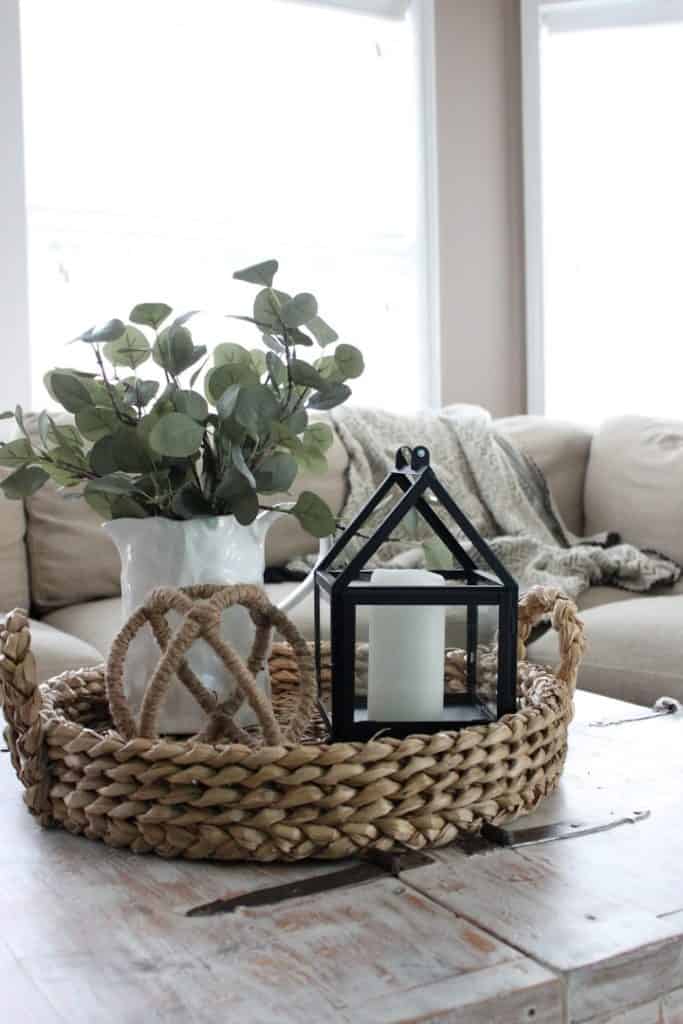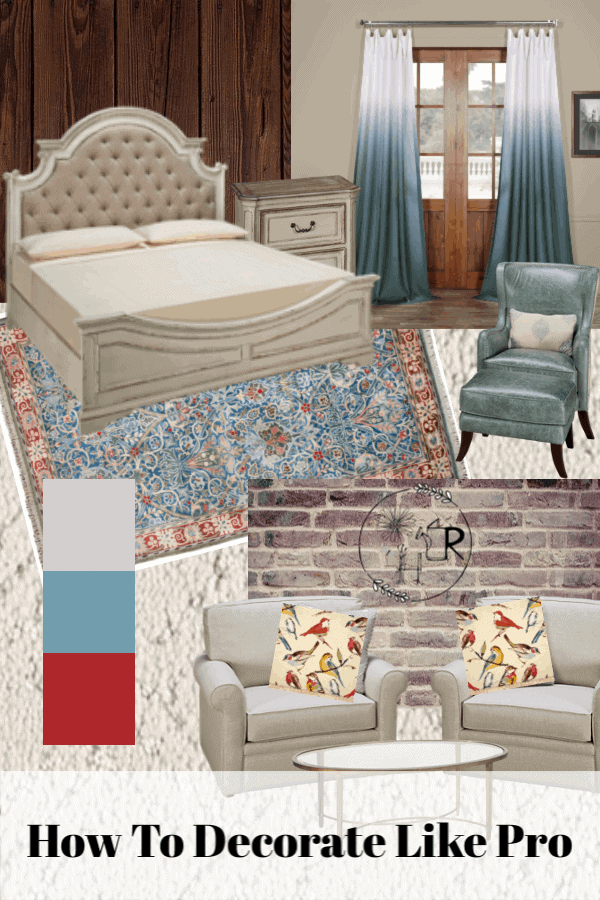How to Decorate Like A Pro
Many people are intimidated by the mere thought of decorating a room in their home. Fear of choosing the wrong color, buying the wrong furniture, or not knowing how to get the look you see in a magazine, are just some of the reasons you may hesitate to decorate your home. Do you want to know how to decorate like a pro?
What if I told you that I could show you how to decorate just like designers do? How about the design elements designers use to decorate their own client’s homes? Finally, what if I showed you how to pull everything together for a beautifully designed space?
In this post, you will learn how to decorate like a pro by…
- Finding your design style
- Coordinating fabric patterns
- Choosing paint colors
- Adding texture
- Making furniture selections
- Determining the function of the room
- Placing accessories
- And how to pull all these together with a mood board

1. Finding your design style
Everyone has their own design style, even you. I know what your thinking…”Have you seen my home? I wouldn’t call this a style!” And you could be right. But, it isn’t because you don’t have a style, it’s because you don’t know what your style is or you don’t know how to implement it.
There are many different ways to determine what your design style is, but one of my favorites is using visuals.
Use visuals to find your style
This method is by far the easiest way to determine what your design style is. And nope, you do not have to know the difference between traditional and contemporary, or industrial and mid-century. You don’t have to know anything except what looks good to you.
I want you to pick your favorite way to browse for design inspiration. Some common ones are Pinterest, magazines, or TV shows. It really doesn’t matter which it is, but it is important that you pick one that you enjoy and one that you typically find a lot of ideas that you’d like to incorporate into your own home.
My personal favorite is Pinterest. If you are unfamiliar with Pinterest then I highly suggest you go and check it out. Pinterest is a website where you can search for literally anything and create “boards” (little virtual bulletin boards), where you “pin” (or save) the information to refer back to later. It is a very visually based search console with beautiful images and is perfect for finding your design style. Therefore, it is a great way to learn how to decorate like a pro. Check it out! http://www.pinterest.com

You might like this…
Already know that you love the Boho Style? Then read my post “Breathe life into your bathroom with Boho Style”
FYI, here is a quiz from Wayfair that may give you some direction to what your design style may be.
Collecting Images to help you decorate
No matter which method you choose I want you to “collect” images of rooms. Without thinking about it too hard, if you like the image, save it. You don’t even have to know why you like it, but if you do, save it.
For example, you can clip images from a magazine and put them in a binder. Make some boards on Pinterest. Or, look up an episode of a show online and save some pictures on your computer. Whatever way is easiest for you… just start a collection.
Here are some examples of why you might save an image…
- First, it could be a whole room or something in the room that you like. But you do not have to identify it.
- Maybe, its products you like such as furniture, accessories, curtains, rugs, that you like.
- Don’t forget colors from paint swatches, your favorite colors, colors in some artwork, your clothing, or even from nature.
- What about how the image makes you feel? Is it calming, welcoming, or exciting?
- Or, maybe you just simply like it and have no idea why.

Evaluating your decorative images
Once you have a lot of images I want you to spread them out and see if you can find a pattern or recurring theme. Maybe you have a lot of pictures with the same soft colors. Maybe a lot of them have the same type of furniture. Are a lot of them light and bright, or dark and mysterious? Do they have a lot of furniture and accessories, or are they minimalist and bare? Now sit down and spend some time with them and see if something is standing out to you. There very well could be a few different reasons you like these photos. Next we’ll group them into sections and label them with why you like them.
Here are some examples of labels you could use…
- I like these because of the colors.
- The furniture in these pictures are simple and not ornate.
- All of these images have natural wood elements like beams, wood floors, stained trim.
- These images have white walls and I really like that look.
- I like all of the metal elements in these photos.
Then, before you know it you will understand just what you like about each one of those images and I guarantee that you will find your style repeating itself over and over.



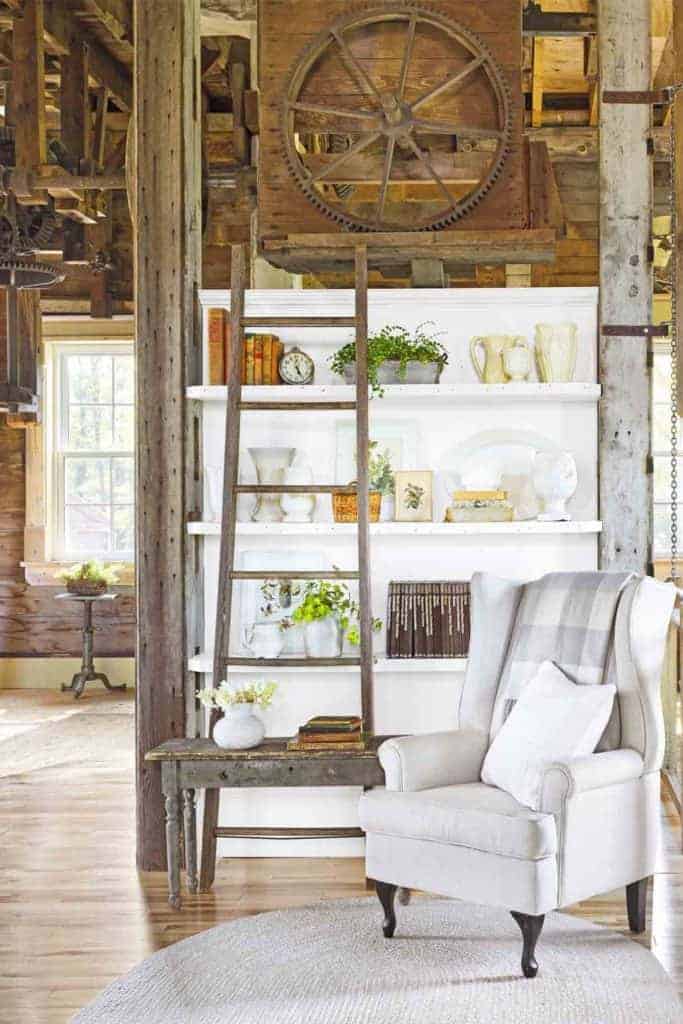
2. Coordinating Patterns
Coordinating fabric patterns is one of the hardest parts of tying a room together. I bet you’ve seen a lot of rooms with beautiful fabrics that you would never have put together… but somehow they work. How do they do it? It’s not as hard as you think. So, here are a few little tricks to making sure your patterns will work together.
Find your inspiration piece
Whenever I design a room I like to start with an inspiration piece. This could be a piece of artwork, an area rug, a throw pillow, or a family heirloom. As long as it has some type of pattern, usually with different colors as well, it will be a great place to start. Remember, you will want to make your inspiration piece be the one thing that you absolutely love and would like to build the whole room around.


You might like this…
Need help with choosing an area rug for your living room? Get all my tips and tricks!
How to decorate with Scale
Now that you have that one piece that makes your heart flutter we are going to learn how to pull in other patterns that work with it.
First, to make different patterns work together you must consider the scale of the pattern. Scale is how big or small the pattern is. To mix different patterns you want to make sure you are using different scales.
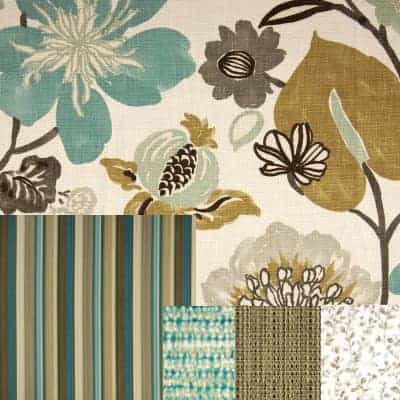
The decorating rule of 3
Second, most designers will use the rule of 3 to pick patterns for a room. It’s a law of nature that 3 of anything is the most pleasing to the eye. So you will want to choose 3 different patters with different scales.
So determine what scale your inspiration piece is, then pick two more patterns with a different scale from that piece.
Keep Colors in the same family
Third are the colors. You will want to make sure that you are keeping your patterns in the same color family. For example, pick a few colors from your inspiration piece and use them for your coordinating patterns.
Make one pattern dominate
You will also want to make sure that you don’t use each of the three patterns equally. Choose one pattern to be the main pattern for the room and use the other two in lesser amounts or as accents.
Typically, you would use an area rug or other large piece such as artwork for your main pattern. This makes sense because of the amount of space it would take to fill it. It’s also a great place to start choosing your other colors and patterns because there are usually lots of different colors in those pieces to pull from.

Mix with neutrals or solids
Then, to finish off the room you will want to mix in some neutrals or solid colors. Typically solid colors, or neutral patterns, act like a neutral that will work with most patterns. Again, just make sure to stay in the same color family.
Typically, you would use the neutrals or solid colors in large furniture pieces. This is good for two reasons. First, the pieces are large enough that a bold pattern would compete with other patterns in the room. And second, if you stay with a neutral or solid color you could easily swap out accessories such as pillows and throws to change out the look without spending a lot of money. See “Make one pattern dominate”
3. How to Choose Paint Colors in your Decorating
Choosing paint colors for your walls should come after you have chosen your fabric patterns for the room. And there is a very simple reason why. You can match a paint color to anything, but you can’t always coordinate a pattern with a paint color.
If you have ever gone shopping to find a rug or pillow to match a specific color you will know what I mean. You could spend hours, days, weeks or even months looking for something that works with it. This is why I recommend picking the patterns first then coordinating a paint color. Paint companies can match anything to a paint color. Therefore, you can bring in a piece of fabric, a family heirloom, a photo from a magazine and they can color match it.
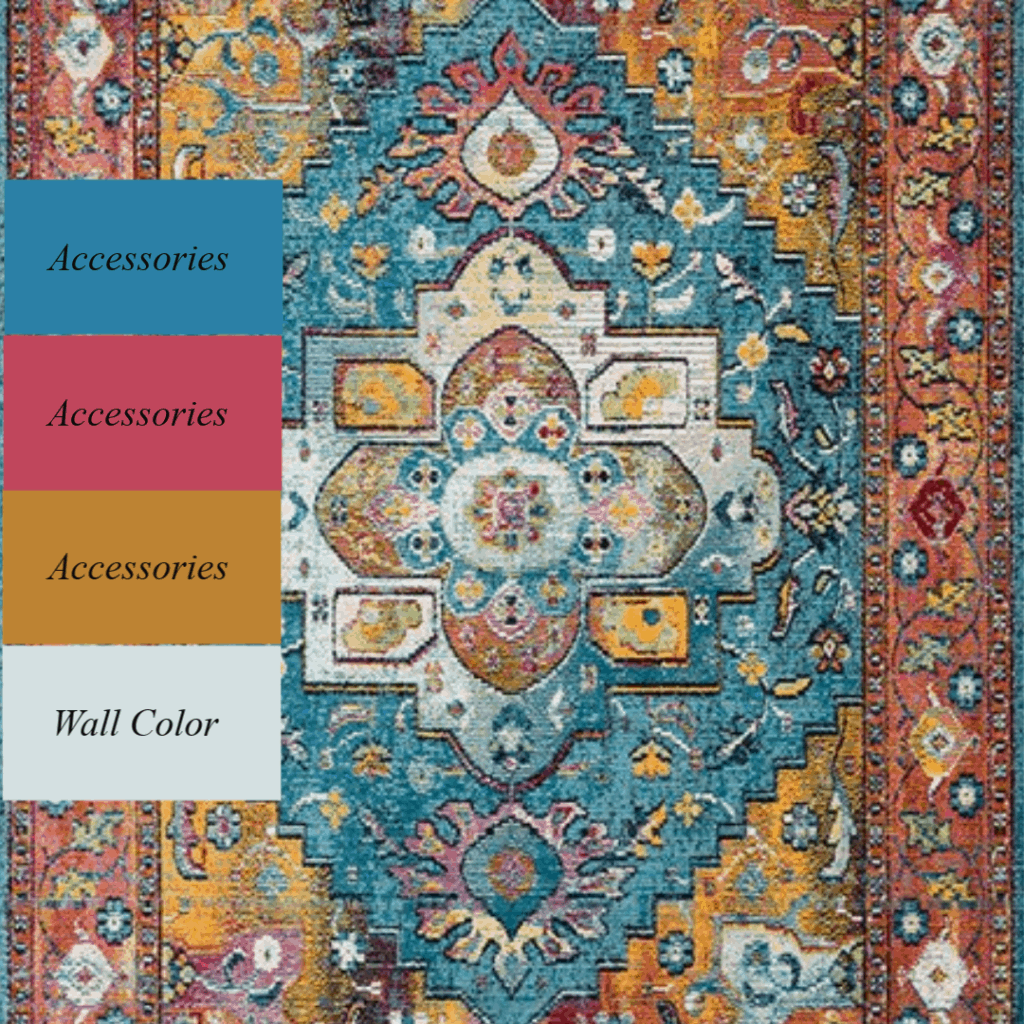
I suggest that you look at your inspiration photos and see if they have anything in common with color on the walls. Do a lot of them have white walls? Or, do most of them have a specific color? The answers to these questions will help you decide what direction you should go.

You might like this…
If you decide that choosing a color for the walls is the way you want to go, then read my post first, “How to choose the right color the first time“
4. Adding Texture to the design
Texture is a very important element in designing a space. Without texture, a room can feel flat and uninviting, especially if it’s a neutral space. Adding texture can make a room come alive. This is a huge tip for how to decorate like a pro.

Some ways you can add texture are…
- With textiles like throws, blankets, pillows, window treatments
- Or rugs… carpet or area rugs come in all kinds of different textures
- Plants will add another layer of texture and can also fit into different styles
- By adding different furniture types such as wood, upholstered, shiny, rustic, furry, leather, etc.
- Using accessories such as books, ceramic vases, wood candlesticks, woven baskets
- And even elements built into the room can have texture such as a brick fireplace, ornate moldings, wood floors, shiny fixtures
So, make sure you have plenty of texture around the room and you will have a very welcoming and interesting space.
5. Making furniture selections
Choosing the right furniture for your space will depend on a few things. Remember the exercise on choosing photos? Look at them again and see if there are similar elements in the types of furniture in those rooms. Is the furniture big and chunky or slim and straight? Are there a lot of upholstered pieces or more wood and metal? Is the furniture more ornate or simple?
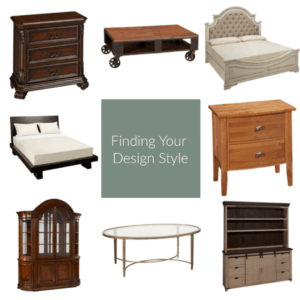
By asking yourself those questions it should help you determine your style of furniture, but what about what type of furniture you need? For example, you may need sofas, chairs, tables, and an entertainment center. Needless to say, you have to figure out what pieces you need in the room and, in order to do that, you will need to determine the function of the room.

You might like this…
Need to learn how to arrange your furniture in your room? Read my post “How to arrange two sofas in a living room” for some great ideas for furniture arranging.
6. Determining the function of the room
Designers can design a beautiful room, but if the room doesn’t work for the client, they will not be happy with it. Therefore, it doesn’t matter how good the room looks if you can’t use it the way you intended. You must determine how you are going to use this room and make sure that you have everything you need to make it work properly.
For instance, you can’t have a conversation with guests if you have to scream across the room because your furniture is placed too far apart. Or, why have a reading room if you don’t have enough light to read a book? And finally, how could your husband watch TV if his favorite chair doesn’t face it?
So take a moment and make a list of everything that you will use this space for and make sure you have all the furniture and lighting you will need to make it function properly. Make sure when you are arranging your space that you consider how everything will work.

You might like this…
For more information about arranging your furniture, get my e-book “How to redesign a room, In one day, Without spending a dime”
7. How to use accessories in your design
Choosing your accessories is like picking jewelry to complete your outfit. It’s the icing on the cake. The garnish on your plate. Therefore, your accessories will make or break your design so choosing them is important.
Accessories can include items like throw pillows, books, small decorative items, throws, collections, baskets, dishes, plants and floral arrangements, trays, artwork, and many more.
First things first, you want to make sure your accessories fit with the style of your room. Again, look at those photos you collected and see what types of accessories they used in the space. Do they use a lot of accessories or just a few statement pieces? Are they slick and shiny or worn and rustic? Take some time to become aware of different ways they used them.
So, how do you use accessories to decorate like a pro? There are some rules for accessorizing that can help you create a visually appealing arrangement. For example you must use balance, scale and proportion when placing your accessories. Balance, focal point, function, heights and levels, lighting, rules of 3, and grouping smaller items are some things I explain in my e-book “How to redesign a room” . These rules are just too extensive to explain here, so go on over and read all about it there.

You might like this…
Learn more about accessorizing your home here “How to accessories your home“
8. How to decorate a mood board
So far, we have discussed how to find your design style, coordinate fabric patterns, choose paint colors, add texture, make furniture selections, determining the function of the room, and how to place accessories. Now we need to discuss how to pull all of those ideas together to make your room complete by making a mood board.
A mood board is simply a visual reference of how the decisions you have made about your room will work together. And making a board is really fun!
Gather your supplies
Now, grab a piece of cardboard, foam board, or poster board approximately 2′ x 3′ and some glue or tape. The size doesn’t really matter it’s whatever your comfortable working with. Next, grab those inspiration photos. We are going to go back to elementary school to make a college of sorts.

We will start by choosing one or two of your favorite room photos. Next pick some furniture from your inspiration photos, or actual photos from furniture websites or catalogs, that you want in your room. Then do the same for accessories, rugs, and window treatments. Finally, we are going to cut them out neatly.
Next I want you to gather some paint swatch ideas for your wall colors, trim colors, and accent colors.
You can also use a floor plan of your room and cut that out as well.

You might like this…
If you don’t know how to make a floor plan, then read my post “How to draw a floor plan to scale”. This post will give you a step-by-step tutorial on how to make a floor plan for your space.
Now, collect some furniture swatches and the fabric patterns you chose earlier and cut them into small squares approximately 3″ x 3″ or bigger/smaller depending on your board size.
Time to play decorator
Now for the fun part, your going to play around with all of those items. Move them around on your board. Exchange some colors, patterns, furniture, etc. until everything looks just they way you want it to. You will be able to “feel” if you’ve got it right. If it doesn’t feel right, then keep playing around with it until it does. Finally, once you have it right, glue those pieces down.
You now have a designer mood board that has pulled all of the elements you choose from all of the above exercises. This should give you a visual interpretation of just how your room would look and feel in real life.
By following the rules above and putting them together on a board, you will have all the knowledge you need to decorate like a pro.
If you have any questions about designing a room leave them in the comments below. If you make your own design board I’d love to see it!


